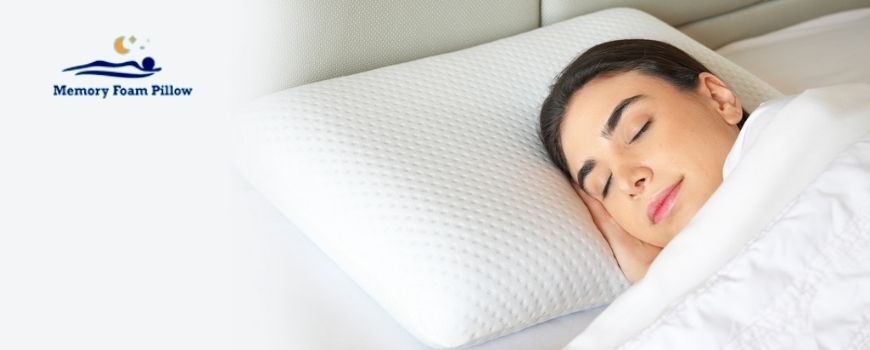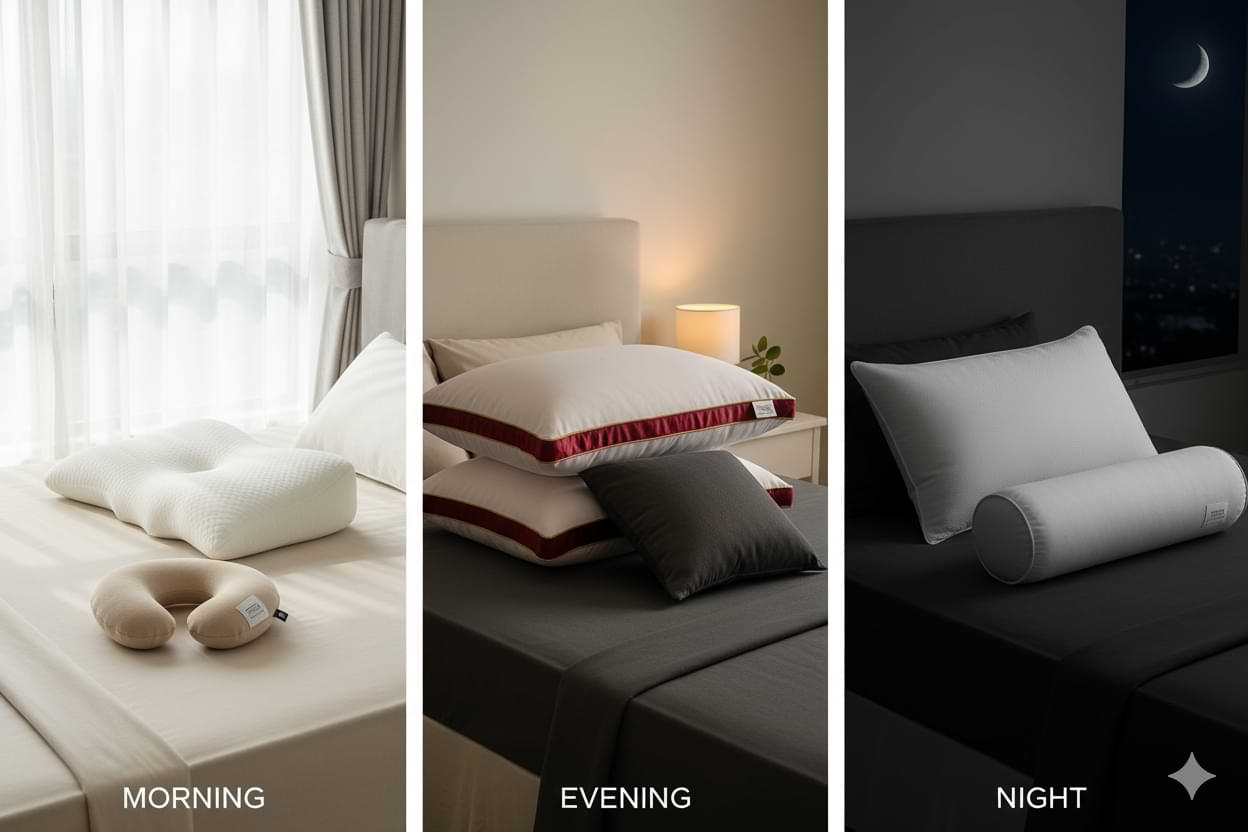
Which Pillow Should Be Used at What Time?
In the quest for a perfect night’s sleep and a pain-free day, we often invest in the right mattress but overlook a crucial component: the pillow. Your pillow is not a one-size-fits-all accessory; it’s a therapeutic tool that should change with your body’s evolving needs. Using the wrong pillow can lead to neck stiffness, back pain, and disrupted sleep, while the right one can be a game-changer for your health and well-being. So, how do you navigate the vast landscape of options, from the contour-hugging Memory Foam Pillow to the specialized Cervical Pillow and the body-cradling Pregnancy Pillow? This definitive guide will walk you through which pillow to use, and more importantly, when to use it, ensuring you make an informed decision for every stage of life and every specific need.
Understanding Your Sleep Position: The Foundation of Pillow Choice
Before diving into specific pillow types, your primary sleep position is the most critical factor. Your posture during sleep dictates the level of support your head and neck require. Side sleepers need a higher, firmer pillow to fill the gap between their ear and shoulder, keeping their spine in a neutral alignment. Back sleepers require a medium-height pillow that supports the natural curve of their neck without pushing their head too forward. Stomach sleepers, ideally, should use a very soft and flat pillow, or even no pillow at all, to avoid craning their neck at an extreme angle. Recognizing your dominant position is the first step in selecting a pillow that works in harmony with your body, preventing morning aches and promoting restorative rest.
The All-Rounder: When to Invest in a Memory Foam Pillow
A Memory Foam Pillow is one of the most popular choices for good reason. It is designed to react to body heat and weight, moulding precisely to the contours of your head and neck. This personalized support makes it an excellent all-rounder. You should consider a memory foam pillow if you suffer from chronic neck or shoulder pain, as it provides consistent pressure relief. It’s also ideal for combination sleepers who change positions throughout the night, as the foam adapts to your movements. However, be mindful of the density; high-density foam offers more support for side sleepers, while a medium-density option is better for back sleepers. If you tend to sleep hot, look for a gel-infused or ventilated memory foam variant to enhance breathability.
For Chronic Neck Pain: The Targeted Support of a Cervical Pillow
When neck pain is a persistent issue, a standard pillow often falls short. This is the precise moment to introduce a Cervical Pillow into your sleep routine. Also known as an orthopedic or neck pillow, its design is specifically engineered to support the natural curvature of your cervical spine. Many cervical pillows feature a Contour Pillow design with a central depression for your head and a raised, supportive bolster for your neck. This structure helps to gently stretch and realign the vertebrae, relieving pressure on the nerves and muscles. They are highly recommended for individuals recovering from whiplash, dealing with arthritis, or those with diagnosed cervical spondylosis. Using a cervical pillow consistently can significantly reduce morning stiffness and headaches originating from the neck.
Supporting the Baby Bump: The Embrace of a Pregnancy Pillow
Pregnancy transforms a woman’s body, bringing about unique physical challenges, particularly during sleep. A Pregnancy Pillow is not a luxury but a necessity during this special time. These elongated, U-shaped or C-shaped pillows are designed to be hugged and wrapped around the body, providing support exactly where it’s needed. You should start using one as early as the second trimester when back pain and the need for side-sleeping become more pronounced. It supports the growing belly, relieves pressure on the hips and lower back, and can be positioned between the knees to align the pelvis. Beyond pregnancy, these pillows are fantastic for nursing, providing support for the baby and relieving strain on the mother’s arms and back. A high-quality microfiber pillow fill is often used in these for its softness and hypoallergenic properties.
Combating Acid Reflux and Snoring: The Inclined Relief of a Wedge Pillow
If you struggle with acid reflux (GERD), heartburn, or snoring, the solution might lie in the angle of your sleep. A Wedge Pillow is a triangular-shaped pillow that creates a gentle, inclined slope. By elevating your upper body, gravity helps keep stomach acid down in the digestive tract, preventing it from rising into the esophagus. This elevation also helps open up airways, which can reduce or eliminate snoring and improve breathing for those with mild sleep apnea. Use a wedge pillow directly under your mattress topper or sheet for a stable incline. It can also be used in conjunction with a standard pillow for head support. This is a targeted therapeutic tool best used when specific medical symptoms disrupt your sleep.
Beyond the Bed: The Postural Aid of a Lumbar Support Pillow
Pillows aren’t just for sleeping. Proper support while sitting is crucial for spinal health, and this is where a Lumbar Support Pillow proves its worth. You should use one whenever you are seated for prolonged periods—in your office chair, during long car rides, or even on your sofa at home. Placed in the curve of your lower back, it helps maintain the spine’s natural ‘S’ shape, preventing slouching and reducing strain on the lumbar discs and muscles. This simple addition can prevent and alleviate lower back pain, improve posture, and increase comfort during extended sitting sessions. It’s an essential tool for anyone with a desk job or a history of lower back issues.
For Tailbone Pain: The Seated Comfort of a Coccyx Pillow
Similar to the lumbar pillow, a Coccyx Pillow (or donut pillow) serves a very specific purpose. It is designed for individuals suffering from pain in the tailbone (coccyx) region. This pain can result from an injury, prolonged sitting on hard surfaces, childbirth, or conditions like pilonidal cysts. The pillow features a unique U-shape or a cut-out center that relieves all direct pressure from the sensitive tailbone area, allowing it to heal without constant irritation. You should use a coccyx pillow whenever you need to sit down, whether at a desk, in a car, or at home. By redistributing your body weight to the surrounding buttocks and thighs, it makes sitting comfortable and pain-free.
The Eco-Conscious Choice: The Cool Breathability of a Bamboo Pillow
For the sleeper who prioritizes sustainability, temperature regulation, and hypoallergenic materials, a Bamboo Pillow is an excellent choice. While the term often refers to the pillowcase made from bamboo-derived viscose, many pillows now use bamboo-derived fills or are marketed with bamboo covers due to their inherent properties. You should choose a bamboo pillow if you are a hot sleeper, have sensitive skin, or suffer from allergies. Bamboo fabric is highly breathable, moisture-wicking, and naturally resistant to dust mites and bacteria. Paired with a supportive fill like shredded memory foam, it offers a cool, clean, and comfortable sleep surface that is also kind to the environment.
For Meditation and Relaxation: The Unique Shape of a Butterfly Pillow
While not typically used for overnight sleep, the Butterfly Pillow deserves a mention for its unique therapeutic application. Named for its shape that resembles butterfly wings, this pillow is specifically designed for use during yoga, meditation, and physical therapy. Its contoured design is perfect for supporting the knees during side-lying positions, for cushioning under the ankles during certain yoga poses, or for providing comfortable support in restorative, meditative postures. You should use a butterfly pillow to enhance your mindfulness practice, aid in gentle stretching, or provide targeted comfort during relaxation exercises that require precise body alignment and cushioning.
The Budget-Friendly and Hypoallergenic Option: A Microfiber Pillow
When cost, softness, and easy maintenance are your primary concerns, a Microfiber Pillow is a reliable and accessible choice. Filled with fine polyester fibers, these pillows are typically very soft, lightweight, and machine-washable, making them a great option for children’s beds, guest rooms, or for anyone who prefers a fluffy, down-like feel without the allergens or high cost of down. They are generally hypoallergenic and resistant to dust mites. However, they may lack the supportive structure of foam-based pillows and can flatten over time, requiring fluffing or replacement. Choose a microfiber pillow for its convenience, affordability, and plush comfort when advanced orthopedic support is not a primary need.
Conclusion
Choosing the right pillow is a dynamic and personal decision that should be based on your current health, sleep habits, and lifestyle. There is no single “best” pillow for everyone, but there is a perfect pillow for every situation. Whether you need the targeted relief of a Cervical Pillow for a stiff neck, the full-body embrace of a Pregnancy Pillow, the inclined therapy of a Wedge Pillow, or the simple, cool comfort of a Bamboo Pillow, understanding the “when” and “why” empowers you to transform your sleep from a mere necessity into a powerful tool for health and rejuvenation. Listen to your body, assess your needs, and invest in the support it deserves.
Frequently Asked Questions (FAQs)
1. How often should I replace my pillow?
Most pillows should be replaced every 1 to 2 years. Higher-quality pillows like memory foam may last 2-3 years. Signs you need a new pillow include persistent stains and odours, constant lumpiness, and waking up with neck or shoulder pain.
2. Can one pillow serve multiple purposes?
Some pillows are versatile. For example, a Wedge Pillow can be used for reading in bed, alleviating acid reflux, and providing support for someone recovering from surgery. However, specialized pillows like a Coccyx Pillow or Cervical Pillow are designed for very specific needs and are less versatile.
3. I’m a side sleeper with shoulder pain. Which pillow is best?
A Memory Foam Pillow or a Cervical Pillow with a higher loft (height) is ideal. It will fill the space between your neck and the mattress, keeping your spine aligned and preventing your lower shoulder from bearing excessive pressure.
4. Are bamboo pillows good for allergy sufferers?
Yes, Bamboo Pillows are an excellent choice. The bamboo-derived viscose fabric is naturally anti-microbial and dust-mite resistant, creating a less hospitable environment for common allergens.
5. What is the difference between a contour pillow and a cervical pillow?
The terms are often used interchangeably. Generally, a Contour Pillow describes the physical shape—a curved design with a depression in the middle. A Cervical Pillow describes the function—a pillow designed to support the cervical spine. Most cervical pillows have a contour shape, making them essentially the same product.
-

ह्यूमिडिफायर कैसे काम करता है?
-

How Long Should You Keep a Memory Foam Pillow?
-

Which Is the Best Humidifier to Buy in India?



